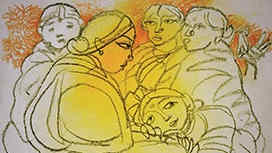Standing on the cusp of traditional and modern Indian art, Ramkinkar Baij played a key role in shaping the idiom of many artists. His influence was evident in the works of Ramananda Bandyopadhyay, Sujit Das, Alay Ghoshal, Soumitra Kar, Atin Basak, Sushobhan Adhikary and Krishnendu Chaki — artists who were brought together by Debovasha in Saptarathi, a seven-week-long exhibition on Facebook for their annual Ramkinkar Utsab.
Although Baij has inspired all seven artists, each of their styles is unique. The magic in the mundane is what Bandyopadhyay takes away from Baij. His mixed media works — the spontaneity of his lines is matchless — are studies in playfulness as the artist catches people off guard in everyday interactions. There is whimsy in Sujit Das’s temperas too, but the focus is on nature: the riot of colours that can coexist without being kitsch only in nature is striking in these idyllic landscapes. Alay Ghoshal’s watercolour landscapes are more traditional, but their liquid tones speak of his skill with a temperamental medium.
Soumitra Kar and Sushobhan Adhikary stood out for the interplay of textures and light and shade, reminiscent of the flowing forms in Baij’s sculptures. Atin Basak combined minimal strokes with a dark foreboding to set the viewer on edge. But the mood was lightened by the cheerful mixed media portrayal of gods and goddesses by Krishnendu Chaki, who flirts with the Bengal style. Hearteningly, the quality of the photographs — often a problem with online exhibitions — conveyed both a visual and a tactile feel of the works.











